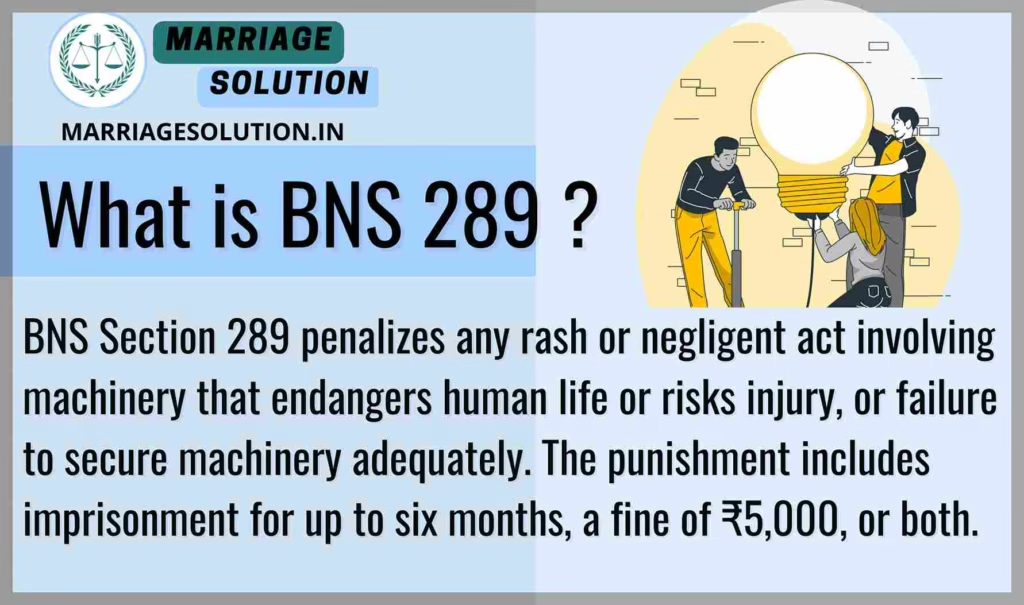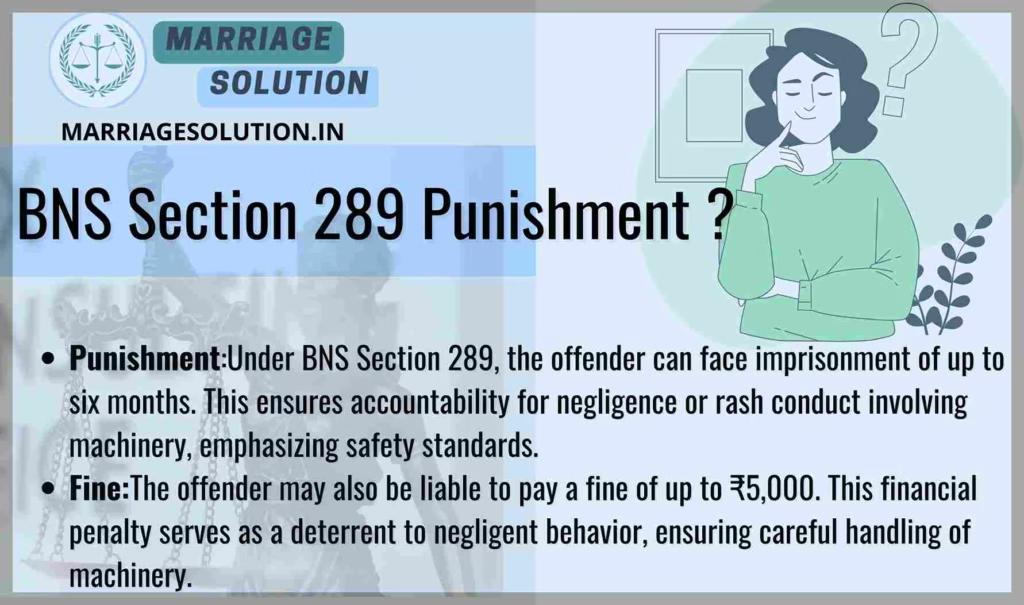Introduction of 289 BNS
289 BNS plays a vital role in ensuring public and workplace safety by penalizing negligent conduct involving machinery. Machinery, whether used in industries, construction sites, or households, can cause severe accidents if not handled responsibly. This law makes it clear that rash or careless actions—such as operating unsafe machines, neglecting repairs, or failing to secure equipment—are punishable. By holding owners, operators, and caretakers accountable, BNS 289 promotes a culture of responsibility, reduces risks of injury, and safeguards human life from preventable accidents.
The Bharatiya Nyaya Sanhita (BNS) Section 289 replaces the old Indian Penal Code (IPC) Section 287.
What is BNS Section 289 ?
BNS Section 289 penalizes any rash or negligent act involving machinery that endangers human life or risks injury, or failure to secure machinery adequately. The punishment includes imprisonment for up to six months, a fine of ₹5,000, or both.

Under Section 289 of the bns act 2023
“Whoever rashly or negligently uses any machinery, or fails to secure it properly, thereby endangering human life or likely causing injury, shall be punished with imprisonment up to six months, or with fine up to five thousand rupees, or with both.”
1. Meaning of Negligent Conduct with Machinery
- This section applies to rash or careless actions involving machinery.
- “Machinery” includes all mechanical devices, from factory equipment to construction tools or transport machinery.
- The offence covers using unsafe machines or failing to secure/maintain them properly.
- Actual harm is not necessary — even the likelihood of danger makes the act punishable.
- The law aims to promote safe handling of machines and prevent avoidable accidents.
2. Who is Covered?
This section applies to:
- Machine operators – careless or reckless in use (e.g., ignoring safety switches).
- Employers/Factory owners – failing to enforce machine safety rules.
- Contractors – leaving cranes, lifts, or heavy machinery unsecured in public spaces.
- Individuals – anyone using household or workplace machinery negligently.
- Transporters/Mechanics – not securing moving machinery that may injure others.
3. Nature of the Offence
- Non-Cognizable → Police cannot arrest or investigate without Magistrate approval.
- Bailable → Accused has the right to bail.
- Non-Compoundable → Cannot be settled privately; must go through court.
- Triable by → Any Magistrate.
4. Examples of BNS Section 289
- Example 1 – Factory Negligence
A factory supervisor ignores safety protocols and allows workers to operate a faulty machine, leading to injuries. → Covered under Section 289. - Example 2 – Unsafe Crane Storage
A contractor parks a crane without securing its boom, which collapses and endangers nearby workers. → Punishable offence. - Example 3 – Careless Use of Power Tools
A worker uses a power saw without protective gear and leaves it running unattended. → Risky negligence under this section. - Example 4 – Elevator Negligence
A building owner fails to maintain an elevator, and passengers are endangered when it malfunctions. → Liable under Section 289.
5. Punishment under BNS Section 289
- Imprisonment → Up to 6 months.
- Fine → Up to ₹5,000.
- Both → Court may impose imprisonment and fine in serious negligence cases.
6. Importance of BNS Section 289
- Protects workers and the public from machinery-related hazards.
- Encourages factories, industries, and contractors to maintain safety standards.
- Ensures legal accountability for both action (rash use) and omission (failure to secure).
- Reinforces that negligence itself is a punishable offence, even without actual harm.
- Promotes a culture of industrial and workplace safety in India.
Section 289 BNS Overview
BNS Section 289 deals with negligent or rash conduct involving machinery that endangers human life or risks injury. It ensures individuals handle machinery responsibly and secure it properly to avoid accidents. Violations under this section attract imprisonment of up to six months, a fine of ₹5,000, or both. The offence is bailable, non-cognizable, and triable by any Magistrate.
BNS Section 289: 10 Key Points Explained in Detail
1. Definition of Negligent Conduct with Respect to Machinery
BNS Section 289 penalizes anyone who negligently or rashly uses machinery in a way that endangers human life or causes possible harm. It also includes failing to take proper precautions with machinery under one’s care. This ensures accountability and safety in operations involving potentially dangerous machines.
2. Scope of Machinery
This section applies to any machinery, ranging from heavy industrial equipment to smaller mechanical devices. The law emphasizes proper usage and maintenance to prevent accidents, covering a wide range of scenarios in industries and public spaces.
3. Act of Rashness or Negligence
Rashness involves reckless actions with machinery, while negligence refers to carelessness in handling or maintaining it. For example, operating a machine without safety measures or neglecting to repair a malfunctioning part can fall under this provision.
4. Failure to Take Precautions
The section also punishes the omission of necessary safety measures with machinery. If a person knowingly skips safety checks or fails to secure hazardous machinery, causing potential danger, they are held liable under this section.
5. Risk to Human Life
The primary concern of this law is human safety. It targets conduct that endangers human life or could cause physical harm. For instance, operating machinery without proper guards in a workplace can result in severe penalties if it endangers workers.
6. Punishment for the Offense
The punishment for violating BNS Section 289 is imprisonment for up to six months or a fine up to ₹5,000, or both. This ensures a deterrent against negligent conduct while emphasizing both financial and personal accountability.
7. Nature of the Offense
The offense is classified as non-cognizable, meaning the police cannot arrest the offender without prior approval from a magistrate. It is also bailable, allowing the accused to secure release by providing bail.
8. Legal Proceedings and Trial
The offense under Section 289 is triable by any magistrate, ensuring accessibility to judicial redress. This allows for faster resolution of cases related to machinery negligence.
9. Non-Compoundable Nature
The offense is non-compoundable, meaning it cannot be settled privately between the parties. This ensures that negligence with machinery, which can affect public safety, is addressed formally in court.
10. Importance of Preventive Measures
The law emphasizes the importance of preventive measures, such as regular maintenance and adherence to safety protocols. By penalizing negligence, the law promotes a culture of responsibility in handling machinery, ensuring the safety of individuals and communities.
Examples of BNS Section 289
- Negligent Operation in a Factory:
A factory worker, while operating a machine, ignores safety protocols and fails to shut it down properly. This negligence leads to an accident causing injury to a co-worker. - Improper Machinery Storage:
A contractor stores a heavy crane without securing its parts. Due to negligence, the machinery topples, endangering nearby workers and passersby.
BNS 289 Punishment
- Punishment:
Under BNS Section 289, the offender can face imprisonment of up to six months. This ensures accountability for negligence or rash conduct involving machinery, emphasizing safety standards. - Fine:
The offender may also be liable to pay a fine of up to ₹5,000. This financial penalty serves as a deterrent to negligent behavior, ensuring careful handling of machinery.

BNS 289 bailable or not ?
BNS Section 289 is a bailable offense, meaning the accused has the right to be released on bail. The accused can apply for bail to avoid being detained during the trial process.
Comparison table of BNS Section 289 vs IPC Section 287
| Section | What it Means | Punishment / Consequence | Bailable | Cognizable | Trial By |
|---|---|---|---|---|---|
| BNS Section 289 | Addresses negligent or rash conduct involving machinery that endangers human life or is likely to cause injury. Covers both improper operation and failure to secure or maintain machinery. | Imprisonment up to 6 months, or fine up to ₹5,000, or both. Enforces responsibility for machinery safety and prevents industrial accidents. | Bailable | Non-Cognizable | Any Magistrate |
| IPC Section 287 (Old) | Penalized negligent conduct with respect to machinery likely to endanger human life or cause injury. Narrower in scope and limited to simple negligence without modern safety emphasis. | Imprisonment up to 6 months, or fine up to ₹1,000, or both. Lower fine and less stringent on safety accountability compared to BNS 289. | Bailable | Non-Cognizable | Any Magistrate |
| Key Difference: BNS Section 289 enhances safety accountability with a higher fine (₹5,000 vs ₹1,000) and broader coverage for both rash acts and omissions in machinery handling. It modernizes industrial safety standards under Indian law. | |||||
BNS Section 289 FAQs
What does BNS Section 289 address?
It deals with negligent or rash conduct involving machinery that endangers human life or risks causing harm.
What is the punishment under BNS Section 289?
The punishment includes imprisonment of up to six months or a fine of up to ₹5,000, or both.
Is the offense under BNS Section 289 bailable?
Yes, it is a bailable offense, allowing the accused to secure bail.
Is BNS Section 289 a cognizable offense?
No, it is a non-cognizable offense, meaning police need magistrate approval to investigate or arrest.
What kind of acts fall under BNS Section 289?
Acts like operating machinery carelessly, failing to secure it, or ignoring safety precautions fall under this section.
Conclusion
BNS Section 289 serves as an important safeguard against negligence in handling machinery. By prescribing imprisonment or fines, it emphasizes that carelessness in operating or maintaining machines is not just a personal lapse but a public safety concern. This section updates and strengthens the earlier IPC provision by imposing stricter accountability and higher penalties. Ultimately, it encourages industries, contractors, and individuals alike to adopt preventive safety measures, thereby reducing workplace hazards and ensuring a safer environment for society.
Need Legal Support?
If you are dealing with court cases, marriage problems, or any other legal issue, our team at Marriage Solution – Lawyer Help is here for you. Simply fill out our quick online enquiry form, and we’ll connect you with the right legal expert to support your needs.
Finished with BNS 289 ? Continue exploring the next provisions of the Bharatiya Nyaya Sanhita (BNS), 2023. Each section includes explanations, examples, and plain-language breakdowns for easy understanding.
- 290 BNS : Negligent conduct with respect to pulling down, repairing or constructing buildings etc.
- https://marriagesolution.in/bns_section/290-bns/
- Section 291 BNS : Negligent conduct with respect to animal.
- https://marriagesolution.in/bns_section/section-291-bns/
- 292 BNS : Punishment for public nuisance in cases not otherwise provided for.
- https://marriagesolution.in/bns_section/292-bns/
- 293 BNS : Continuance of nuisance after injunction to discontinue.
- https://marriagesolution.in/bns_section/293-bns/
- 294 BNS : Sale, etc., of obscene books, etc.
- https://marriagesolution.in/bns_section/294-bns/
Full IPC Section List: https://marriagesolution.in/ipc-section-list
All Indian Law & Blogs: https://marriagesolution.in/indian-law/
Full BNSS Section List: https://marriagesolution.in/bnss_section-list
